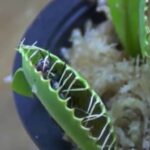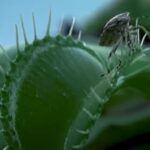As an Amazon Associate, this site earns commissions from qualifying purchases. For more details, click here.
Have you ever bought a Venus flytrap and noticed that after a few days or weeks, it turns red? Sometimes only the trap interior turns reddish, but in other cases it seems like the entire plant. Is this a good or bad sign?
Venus flytraps turn red when exposed to lots of sunlight. If the trap interior is reddish, it means the plant is healthy. Venus flytraps with pale colors need more sunlight.
Why Red is Good For Venus Flytraps
Color is one of the best indicators of plant health. A healthy Venus flytrap has a white rhizome (or bulb), green leaves and is reddish inside the traps. The red can be a bright or dark hue, but it will always be vibrant.
Venus flytraps turn red in reaction to sunlight. The more it receives, the redder and healthier the plant can get. A sickly Venus flytrap turns brown and burns when exposed to too much sun. If it is healthy, the traps turn red and in some cases even the bulb and parts of the leaves.
While all Venus flytraps grow flowering stems, not all turn red. Some variants remain green with plenty of light. Others assume a light red color and others burgundy. So if your Venus flytrap does not become bright red, it does not mean they are not healthy. As long as the plant gets enough light, air and water it will be fine.
But most Venus flytraps do turn red and if yours does, it is not a cause for concern. Take it as a good sign that your plant is doing fine.
Some Venus flytraps change colors due to an environment change. If you had been growing the plant indoors then bring it outside,, the sudden change in location, temperature, humidity and light can bring about rapid changes.
The plant suddenly receives more sunlight, and this could lead to a change in color. The red hue serves as protection from the sun and is good for Venus flytraps in the long run.
How to Turn Venus Flytraps Red
So now we know that red is a good sign for Venus flytraps. The question is how do you do it? There are several steps you can take to produce this effect. The following are going to be most effective if your flytrap is in good health.
Before you proceed, check first what type of Venus flytrap you have. Some types are more likely to turn red than others. Also make certain you have done everything possible to keep it in good health. if the plant is sick, it will never turn red.
Provide More Light
Lack of sunlight causes Venus flytraps to turn yellowish or brown. If the insides of the trap start losing its red hue and leaves curl, it is not receiving enough sunlight.
If your Venus flytrap is indoors, you can use artificial light. The lighting has to be indirect whether it is sunlight or artificial. Venus flytraps need 12 hours of sunlight. A good choice is the GooingTop LED Grow Light as it provides the type of luminosity and warmth that Venus flytraps specifically need.
Light does more than turn Venus flytraps red, it is their source of food. Through photosynthesis, Venus flytraps create glucose which acts as their fuel. They eat bugs as additional supplements to their food.
Feed the Right Nutrients
Venus flytraps benefit from eating a few insects a month. Flies, spiders, and other insects are rich in nitrogen and other elements which the plant converts into growth fuel.
If your Venus flytrap is outdoors it will not have any problems finding bugs to feed on. For indoor plants you can serve them freeze dried food like mealworms or fish food. Feed Venus flytraps every two weeks and that will be enough.
Note that Venus flytraps cannot eat just any kind of food. Do not feed it insects with hard shells like beetles and cockroaches. Small moths are fine, but large winged insects should be avoided because they will eat or rip the trap apart.
Nutrients and glucose go hand in hand just like food and supplements for humans. If you want to see more vibrant red traps, make sure the plant receives enough sunlight and nutrients.
Venus flytraps will turn black if the food is too large. The food quantity should be 1/3 or 2/3 the size of the trap. This ensures the trap can fully close and digest it. This is the perfect complement to glucose.
Venus flytraps only absorb food if the trap is completely closed. The digestive process is long and complex and can take a week or two to finish.
If the food is too big, the trap will turn black while trying to digest it. In some cases this can kill the trap. But this will not harm the plant as it will produce a new leaf to replace it.
Feeding Guidelines
The point is, Venus flytraps need nutrients to flourish. The right amount gives the plant that red color, but too much will harm it.
The rules for feeding are simple though:
- Outdoor Venus flytraps do not need to be fed. The only exception is if there are no insects in the vicinity.
- Give only food that is for these plants, like Jessie Mae Carnivorous Plant Food.
- Indoor Venus flytraps should be fed every two or four weeks.
- You can give give them dead bugs, freeze fried mealworms or fish food.
Keep these in mind and your Venus flytraps should be all right. Remember that these plants do not need to eat during dormancy.
Use the Right Soil
The soil plays a big role in determining how Venus flytraps look. With the right type your plant will grow faster and healthier with vibrant greens and reds.
The best soil for Venus flytraps is a 1:1 mix of perlite and peat moss. There are other options like sphagnum moss mixed with sand. Do not use cactus soil because it can kill Venus flytraps.
The soil you use can make the difference between a living Venus flytrap and a dead one. There is a lot more than just color involved here. By using nutrient poor soil, the ground becomes more suitable for Venus flytraps to grow.
Never use regular potting soil on these plants. Fertilizing the ground will also harm the plant and compromise its immune system. Venus flytraps lose their color due to lack of light or illness, so it is one of the best indicators that you can use.
Place the Plant in a Good Environment
Red Venus flytraps are the product of a healthy environment. Like other living things, Venus flytraps need water, light and air. Combine these with nutrients and the plants will produce vibrant, vivid colors.
A stressful environment is detrimental to plants, including Venus flytraps. Lack of light, poor soil and an ill-fitting container will affect the plant.
These plants will benefit from a 5-10 inch pot. If it is too small, there will not be enough room for its roots to grow. This affects the rest of the plant and leads to loss of its reddish hue and luster.
Do Not Touch Venus Flytraps
If you want to see your Venus flytrap turn red, leave it alone. The only time you should touch the trap is to feed it. Even then, be careful so it does not close while you are still placing food inside
Stop touching Venus flytraps to see if it can bite you. Doing this harms the plant more than it does you. Each trap can only close 3-5 times before it dies. So it needs to conserve energy and must only open to capture an insect.
Each time you poke a trap and force it open, you hasten its demise and waste the plant energy. It takes a lot of resources to produce a trap. If your Venus flytrap does not receive proper nutrition and light, that vivid color will eventually fade.
Color Loss in Dormancy is Normal
Lastly, Venus flytraps lose color and a bunch of leaves when they enter dormancy. This is normal and is good for the plant.
Dormancy takes place over several weeks, but you should expect it in the middle or late fall. Let the plant go dormant until spring when it will awaken and you will see its colors restored.
Once the plant has come back from its dormant period, increase its light exposure slowly. If healthy the plant will start growing new leaves and traps, then you can resume feeding it again.
Conclusion
Venus flytraps are not just carnivorous plants, they are also vibrant and lovely to look at. Knowing why the plant turns red, its meaning and what you should do about it makes caring and nurturing easier.

My fascination with carnivorous plants began many, many years ago with Venus Fly Traps. Now I am more than happy to impart what I know with other enthusiasts and those who are curious about meat eating plants.



